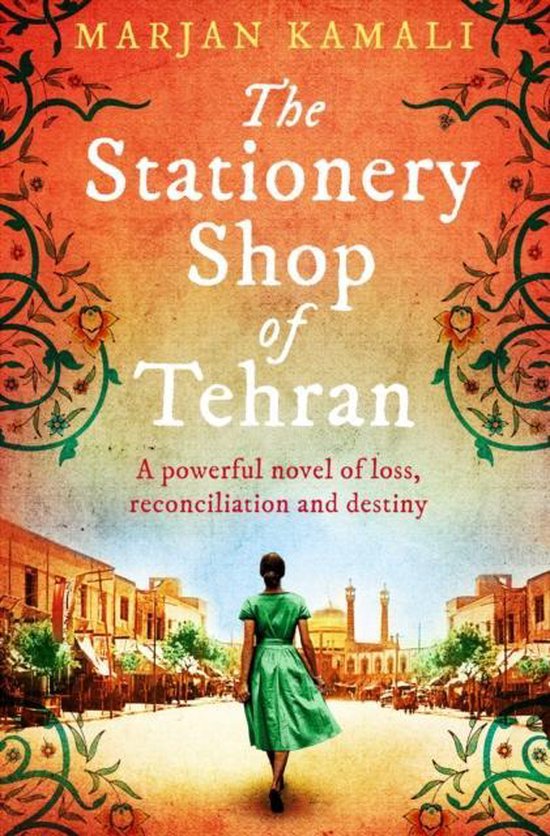I’ve read this book a couple of days ago, but I didn’t give my review straight after I read it because I’m hooked on reading War and Peace – Tolstoy (Anthony Briggs’ translation is an excellent one, if you plan to read this giant).
Tehran 1953. Roya loved to visit a stationery shop that’s ran by Ali Fakhri. She loved poetry, books by famous Russian authors that are translated into Farsi and colourful German stationery items. The stationery shop was her “safe resort” from political discussion about Mossadegh, the Shah and the communist party. There she met Bahman Aslan, a Mossadegh supporte, and the two fell in love with each other that they decided to get married. Roya learned sooner that Bahman’s mother had another girl in mind to marry Bahman. Nevertheless, Bahman and Roya managed to et engaged. At their engagement party, Roya learned about the mental situation of Bahman’s mother. Bahman’s father, in the contrary, was an easy going man who didn’t object about their engagement/marriage. Roya was also shocked to see Ali Fakhri who attended, and she learned that mr. Fakhri and Bahman’s mother actually knew each other.
As soon after their engagement party, Bahman’s family disappeared. Nobody knew where they were. But Roya received letters from Bahman that’s sent via mr. Fakhri’s shop. One day, Bahman told her in his letter to go to Sepah plein, for he has planned to marry her in secret. But on that day, there was an unrest and Roya didn’t meet Bahman.
And then, the story went back to the time when and how Ali Fakhri and Bahman’s mother met each other. Apparently, she was a daughter of a melon’s seller, whose fate changed after she married a man of higher society.
The Shah took over the country. Both Roya and her sister got accepted to study at a university in California and the two began a new life. Roya got married to Walter Archer and they got a baby named Marigold, who died just a year after. But then they got another child. This time a healthy baby boy.
Although Roya had a new life, she never forgot Bahman. She still had contact with Jahangir, which was their friends in Tehran, and Jahangir updated her about how Bahman’s doing.
One day, when Roya was already in her 70’s (she was 77 to be exact), she visited a stationery shop whose owner was apparently an Iranian. There she learned that Bahman also migrated to the USA, and that she was talking to his son. She managed to meet Bahman again and both of them learned why they didn’t meet at Sepah plein, what happened that day and in the end, we as readers are left with a suspicious question.
My verdict:
Although the story is a bit predictable, it’s a moving one. It left me feeling both sad and mad. Sad to know why they didn’t meet each other, sad to know what happened to mr. Fakhri, but I was also mad at Bahman’s mother even I understood why she has done what she has done.
Marjan Kamali has written it beautifully. It feels as if she brought me to Tehran. She opened my eyes that Tehran was not a city full of strict rules. What I meant by strict rules is, there was kissing at public places. I don’t know if this was allowed back then or it’s just fictive, but it just gave me a general idea that Iran was much moderner back then, especially as there’s a modern cafe mentioned in the book. From here I do expect that you, who read this, think that I really, really have no idea about Iran. Yes. It’s true. I had just never expected that there was a modern cafe in Tehran in 1953. My mind about Tehran is like taliban occupying Afghanistan. That it’s not safe there. I don’t know. It’s not my choice of vacation destination, of course. And I also learned something new: that baklava doesn’t only exist in Turkey and Greece.
Synopsis:
Roya, a dreamy, idealistic teenager living amid the political upheaval of 1953 Tehran, finds a literary oasis in kindly Mr. Fakhri’s neighborhood stationery shop, stocked with books and pens and bottles of jewel-colored ink.
Then Mr. Fakhri, with a keen instinct for a budding romance, introduces Roya to his other favorite customer—handsome Bahman, who has a burning passion for justice and a love for Rumi’s poetry—and she loses her heart at once. Their romance blossoms, and the little stationery shop remains their favorite place in all of Tehran.
A few short months later, on the eve of their marriage, Roya agrees to meet Bahman at the town square when violence erupts—a result of the coup d’etat that forever changes their country’s future. In the chaos, Bahman never shows. For weeks, Roya tries desperately to contact him, but her efforts are fruitless. With a sorrowful heart, she moves on—to college in California, to another man, to a life in New England—until, more than sixty years later, an accident of fate leads her back to Bahman and offers her a chance to ask him the questions that have haunted her for more than half a century: Why did you leave? Where did you go? How is it that you were able to forget me?
